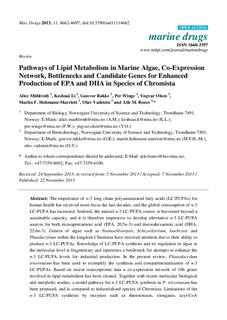| dc.contributor.author | Mühlroth, Alice | |
| dc.contributor.author | Li, Keshuai | |
| dc.contributor.author | Røkke, Gunvor | |
| dc.contributor.author | Winge, Per | |
| dc.contributor.author | Olsen, Yngvar | |
| dc.contributor.author | Hohmann-Marriott, Martin Frank | |
| dc.contributor.author | Vadstein, Olav | |
| dc.contributor.author | Bones, Atle M. | |
| dc.date.accessioned | 2018-01-02T13:15:04Z | |
| dc.date.available | 2018-01-02T13:15:04Z | |
| dc.date.created | 2013-11-22T16:12:54Z | |
| dc.date.issued | 2013 | |
| dc.identifier.citation | Marine Drugs. 2013, 11 (11), 4662-4697. | nb_NO |
| dc.identifier.issn | 1660-3397 | |
| dc.identifier.uri | http://hdl.handle.net/11250/2474063 | |
| dc.description.abstract | The importance of n-3 long chain polyunsaturated fatty acids (LC-PUFAs) for human health has received more focus the last decades, and the global consumption of n-3 LC-PUFA has increased. Seafood, the natural n-3 LC-PUFA source, is harvested beyond a sustainable capacity, and it is therefore imperative to develop alternative n-3 LC-PUFA sources for both eicosapentaenoic acid (EPA, 20:5n-3) and docosahexaenoic acid (DHA, 22:6n-3). Genera of algae such as Nannochloropsis, Schizochytrium, Isochrysis and Phaedactylum within the kingdom Chromista have received attention due to their ability to produce n-3 LC-PUFAs. Knowledge of LC-PUFA synthesis and its regulation in algae at the molecular level is fragmentary and represents a bottleneck for attempts to enhance the n-3 LC-PUFA levels for industrial production. In the present review, Phaeodactylum tricornutum has been used to exemplify the synthesis and compartmentalization of n-3 LC-PUFAs. Based on recent transcriptome data a co-expression network of 106 genes involved in lipid metabolism has been created. Together with recent molecular biological and metabolic studies, a model pathway for n-3 LC-PUFA synthesis in P. tricornutum has been proposed, and is compared to industrialized species of Chromista. Limitations of the n-3 LC-PUFA synthesis by enzymes such as thioesterases, elongases, acyl-CoA synthetases and acyltransferases are discussed and metabolic bottlenecks are hypothesized such as the supply of the acetyl-CoA and NADPH. A future industrialization will depend on optimization of chemical compositions and increased biomass production, which can be achieved by exploitation of the physiological potential, by selective breeding and by genetic engineering. | nb_NO |
| dc.language.iso | eng | nb_NO |
| dc.publisher | MDPI | nb_NO |
| dc.rights | Navngivelse 4.0 Internasjonal | * |
| dc.rights.uri | http://creativecommons.org/licenses/by/4.0/deed.no | * |
| dc.title | Pathways of Lipid Metabolism in Marine Algae, Co-Expression Network, Bottlenecks and Candidate Genes for Enhanced Production of EPA and DHA in Species of Chromista | nb_NO |
| dc.type | Journal article | nb_NO |
| dc.type | Peer reviewed | nb_NO |
| dc.description.version | publishedVersion | nb_NO |
| dc.source.pagenumber | 4662-4697 | nb_NO |
| dc.source.volume | 11 | nb_NO |
| dc.source.journal | Marine Drugs | nb_NO |
| dc.source.issue | 11 | nb_NO |
| dc.identifier.doi | 10.3390/md11114662 | |
| dc.identifier.cristin | 1068501 | |
| dc.relation.project | Norges forskningsråd: 227002 | nb_NO |
| dc.description.localcode | © 2013 by the authors. Licensee MDPI, Basel, Switzerland. This article is an open access article distributed under the terms and conditions of the Creative Commons Attribution (CC BY) license (http://creativecommons.org/licenses/by/3.0/). | nb_NO |
| cristin.unitcode | 194,66,10,0 | |
| cristin.unitcode | 194,66,15,0 | |
| cristin.unitname | Institutt for biologi | |
| cristin.unitname | Institutt for bioteknologi og matvitenskap | |
| cristin.ispublished | true | |
| cristin.fulltext | original | |
| cristin.qualitycode | 1 | |

